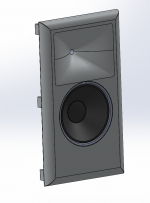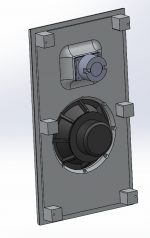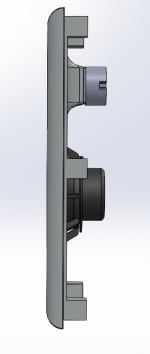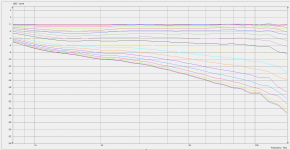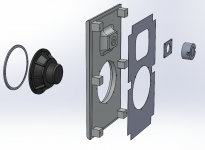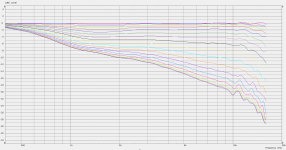On reflection. I'll not bother!
Final sim is running now with higher res and more points.
Whipping up a quick MDF. 12P80ND is slightly recessed held with an aluminium bezel.
I have two 15P80ND that i'm planning to used in a sealed side firing dual opposing.
Cutting some 1.5mm steel sheet to expoxy bond to the back of the baffle to aid damping.
Final sim is running now with higher res and more points.
Whipping up a quick MDF. 12P80ND is slightly recessed held with an aluminium bezel.
I have two 15P80ND that i'm planning to used in a sealed side firing dual opposing.
Cutting some 1.5mm steel sheet to expoxy bond to the back of the baffle to aid damping.
Attachments
Last edited:
So show us 🙂
+1 🙂
Is that with the diffraction of an abrupt termination i.e. no baffle?
//
Last edited:
You can get waterfall from the simulated complex frequency response by converting it to the impulse response, e.g. via VituixCad or any other software that does IFFT. The waterfall then folllows from that. Or maybe even VACS can do that, I can't recall right now. I never tried.
Because I don't think you can do a diffraction trick to extend HF without a penalty in the timing/phase domain and as this don't appear "until later", it will not show in these graphs!?
//
//
Why would it not show? All the information is already there. It may only be a matter of a convenient visualization. I like polar frequency response data - you can see all these things very clearly from that.
BTW, I try to avoid the "diffraction tricks" as much as possible.
BTW, I try to avoid the "diffraction tricks" as much as possible.
So show us 🙂
34% completed on a higher res, more points sim...
See post Acoustic Horn Design – The Easy Way (Ath4)
Last edited:
Yeah, that looks very good!
Something tells me that we are going to see more designs like this now 🙂
Something tells me that we are going to see more designs like this now 🙂
Last edited:
Why would it not show? All the information is already there. It may only be a matter of a convenient visualization. I like polar frequency response data - you can see all these things very clearly from that.
BTW, I try to avoid the "diffraction tricks" as much as possible.
Polar is at time=0. Diffraction means reactive behaviour and will rear its ugly head not until later when energy is released - probably in a none FR linear manner - hence, you will not see that in your current simulations..
//
Planning a short exponential stuffed aperiodic port for the 12P80ND ala LineSource https://www.diyaudio.com/forums/mul...cd-beyma-12p80nd-tpl-150-a-4.html#post4154867
I beg to differ then.
That you still see them or I have the wrong understanding of diffraction?
//
As long as we consider horns linear time-invariant systems (which is done all the time because it is very close to reality), the impulse response is the complete description, including all the diffractions and resonances. Complex frequency response (amplitude; phase) is another form of the same data - and that's what we are able to directly simulate. Thus, we can simulate the impulse response and we can also calculate the waterfall from it. There's simply no other significant phenomenon going on.
Last edited:
This.As long as we consider horns linear time-invariant systems (which is done all the time because it is very close to reality), the impulse response is the complete description. Complex frequency response (amplitude; phase) is then another form of the same data - and that's what we are able to simulate. Thus, we can simulate the impulse response and we can also calculate the waterfall from it. There's no other significant phenomenon to capture.
The frequency response (polars) does not only contain information for time = 0.
/Anton
Basically all the significant duration of the impulse response, i.e. all the information about the system. By convolving the input signal with the impulse response, you can then calculate the response of the system to any input signal in the time domain. This is all already contained in the current simulations.
Last edited:
On reflection. I'll not bother!
Final sim is running now with higher res and more points.
Whipping up a quick MDF. 12P80ND is slightly recessed held with an aluminium bezel.
I have two 15P80ND that i'm planning to used in a sealed side firing dual opposing.
Cutting some 1.5mm steel sheet to expoxy bond to the back of the baffle to aid damping.
Very nice, can't wait for finished photos.
- Home
- Loudspeakers
- Multi-Way
- Acoustic Horn Design – The Easy Way (Ath4)
